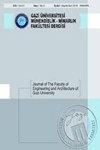Dynamic analysis of historıcal masonry arch bridges
IF 1.1
4区 工程技术
Q3 ENGINEERING, MULTIDISCIPLINARY
Journal of the Faculty of Engineering and Architecture of Gazi University
Pub Date : 2023-09-25
DOI:10.24012/dumf.1314957
引用次数: 0
Abstract
There are many historical bridges belonging to various civilizations in our country. Historical bridges also help us understand the sociological, economic and cultural structures of civilizations that lived between the past and the present. Historical bridges have been deformed due to natural events and human factors and some of them have been destroyed. It is extremely important to know the behavior of these bridges against earthquakes, since a large part of our country is located in a region with high earthquake risk. For this reason, the dynamic behavior of structures is examined with numerical and experimental studies, and earthquake analyzes are made using earthquake acceleration records obtained from past earthquakes or artificial earthquakes. In this direction, it is aimed to strengthen the weak aspects of the structures. For this reason, it is necessary to evaluate the behavior of historical masonry bridges that have survived to the present day in order to carry out restoration and protection. In this article, the historical Sultan Hamid I-II and III bridges in the Askale district of Erzurum province are discussed as a numerical application. These bridges were modeled in three dimensions using the SAP2000 finite element program. First of all, static analyzes of the bridges under their own weight were made. Then, the dynamic properties of the bridges were determined by making modal analyzes. After the dynamic properties of the bridges were determined, dynamic analyzes were made in the time period.historıcal砌体拱桥动力分析
我国有许多属于各种文明的历史桥梁。历史的桥梁也帮助我们理解过去和现在之间文明的社会、经济和文化结构。由于自然事件和人为因素,历史桥梁已经变形,有些已经被摧毁。了解这些桥梁的抗震性能是非常重要的,因为我国很大一部分地区位于地震高风险地区。因此,通过数值和实验研究来检验结构的动力性能,并利用过去地震或人工地震获得的地震加速度记录进行地震分析。在这个方向上,它旨在加强结构的薄弱方面。因此,有必要对留存至今的历史砌体桥梁进行性能评估,以便进行修复和保护。在这篇文章中,历史上的苏丹哈米德I-II和III桥在埃尔祖鲁姆省阿斯卡莱区作为一个数值应用进行了讨论。使用SAP2000有限元程序对这些桥梁进行三维建模。首先,对桥梁在自重作用下进行静力分析。然后,通过模态分析确定桥梁的动力特性。在确定桥梁动力特性后,进行了时间段内的动力分析。
本文章由计算机程序翻译,如有差异,请以英文原文为准。
求助全文
约1分钟内获得全文
求助全文
来源期刊

Journal of the Faculty of Engineering and Architecture of Gazi University
ENGINEERING, MULTIDISCIPLINARY-
CiteScore
1.90
自引率
45.50%
发文量
51
审稿时长
6-12 weeks
期刊介绍:
Gazi University Journal of the Faculty of Engineering and Architecture; Engineering qualifications described below and in the field of architecture research papers and invited articles by scanning is considered to be Turkish.
 求助内容:
求助内容: 应助结果提醒方式:
应助结果提醒方式:


